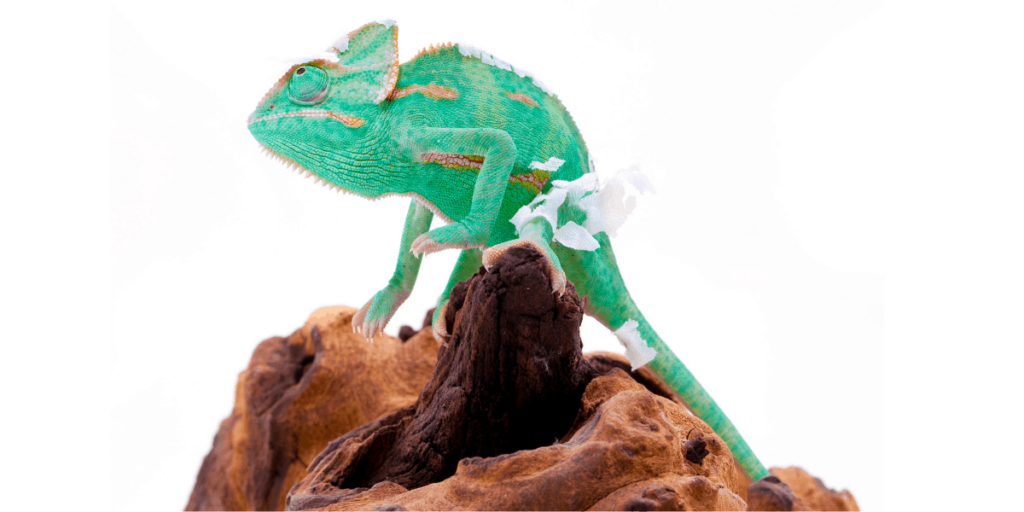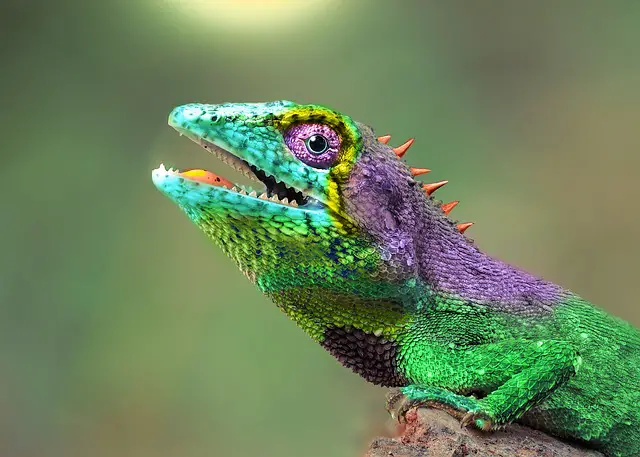If you have recently adopted a pet chameleon, one of the things you were likely looking forward to seeing would be how these amazing creatures shed their skin.
This is a natural process for chameleons and many other reptiles but when you see your pet exhibiting some unusual behavior, this can be a little disconcerting.
You may have noticed that your chameleon started eating his skin after shedding but don’t worry, this is as normal as the shed itself.
There are two main reasons that a chameleon might eat its shed skin; primarily, the animal may be attempting to get nutrients back out of the skin. However, this may also be a behavior that stems from the wild. When chameleons shed their skin, they are leaving a clue behind for predators but by eating the skin, they remove the evidence and avoid making themselves an easy target.
The process of shedding their skin involves much more than the skin merely coming away and the chameleon making a meal of it. If you want to provide the best care for your pet, it is essential that you familiarise yourself with this process.
Chameleon Eating Shed Skin
There are a lot of reptiles that shed their skin and much like their cousins, chameleons shed their skin as they grow. Unlike humans whose skin gradually flakes away without us even noticing it, chameleons do this in a much more dramatic manner.
Once the skin comes away, the chameleon cannot simply leave it where it lands. In the wild, these beautiful lizards are preyed on by a variety of predators.
Snakes are one of the main predators of the chameleon but also a range of mammals such as rats, cats, and even domesticated dogs.
If the chameleon wants to stand any sort of chance of remaining inconspicuous to these animals, it cannot leave any trace of its presence behind.
For this reason, the chameleon will eat its skin after it has shed. This may seem a little odd, gross even, perhaps. But it is an instinctive behavior that cannot merely be eradicated by keeping the animal in captivity.
Moreover, the skin of the chameleon contains a vast number of nutrients that are beneficial to its health. It would be a shame to waste these and so oftentimes, the chameleon will eat his skin in order to gain something back from it.
Does Skin Shedding Hurt My Chameleon?
Since humans do not shed their skin in the same way that a chameleon does, the idea of losing an entire layer that way can seem abhorrent to us. But you must keep in mind that this is a natural event and it doesn’t hurt your pet in any way.
That said, shedding is not without its irks and you may find that the situation is annoying or irritating to the chameleon.

It is not uncommon for these animals to become stressed during a shed and you may seem your pet engaging in behaviors to try and remove the skin more quickly.
One of the most common is where the chameleon gapes its mouth wide open in an attempt to remove the skin that is shedding around it.
When Do Chameleons Shed Their Skin?
Chameleons shed their skin as they grow. This allows them to be comfortable and prevents the skin from becoming too tight.
During their infancy, when they are growing the most quickly, it is not uncommon for these animals to shed their entire skin every three to four weeks. However, this typically stops when they reach around 18 months of age.
When they are young, the animal will shed an entire layer of skin in one go; something akin to a skin suit being taken off. It really is quite the thing to behold.
However, as adults, the frequency of shedding and how cleanly the skin comes away will change somewhat.
There is a common misconception that chameleons will shed their skin when they are stressed. But this isn’t necessarily true. That said, as we have mentioned, the process itself can be stressful for the chameleon.
If your chameleon is shedding, this shouldn’t be taken as a sign of stress, but there are some other things that he may do if he is feeling this way.
Usually, a chameleon will turn a much darker shade as a response to stress or you may notice that the eyes sink back into the head a little more.
Chameleons who are experiencing stress might also become more aggressive and will hiss in response to certain interactions.
How Long Does It Take For A Chameleon To Shed Its Skin?
When they are babies, it may feel as though your chameleon does nothing but shed its skin. As we have discovered, this is because they do it so frequently.
But don’t be alarmed, this is normal. However, it is also essential to attention to how long it takes for the entire skin to be removed.
A well looked after and healthy chameleon should take no longer than three days to shed fully. If it takes any longer than this then it could be an issue with the environment.
You chameleon needs balanced humidity at all times but this moisture becomes even more important when he is shedding. If you are concerned, it may be worth checking the humidity level in his tank.
If this is not the problem, it could be that there is an underlying health issue preventing the shed from being completed.
In this instance, it is important to have your pet seen by a vet who will be able to diagnose and treat the problem. Alternatively, you can help your pet to shed but this should only ever be done as a last resort and you should NEVER attempt to just peel off the skin.
The best approach is to take a wet cotton swab and gently rub the area to remove the skin. Once finished, don’t forget to leave it in case your chameleon wants to eat it.
Conclusion
Chameleons, much like many other reptiles, shed their skin as they grow. This is a normal process and usually happens without much drama.
But if you’re a new chameleon owner and you have noticed your pet eating their shed skin, this can be alarming.
Chameleons do this to gain a few additional nutrients from the skin but this is also an instinctive behavior that comes from the wild and prevents them leaving a trail for potential predators.




